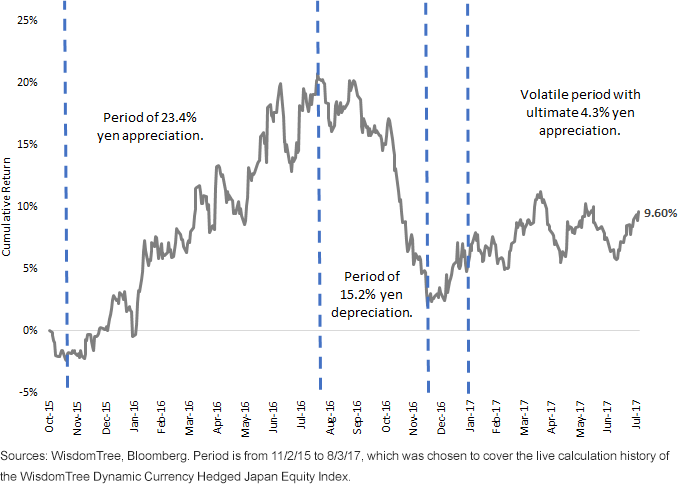We’ve written time and time again about the inverse relationship between the performance of the Japanese yen versus Japan’s equities.1
If the yen is depreciating, companies within Japan that do business abroad get a boost, as their products/services become less expensive and their earnings abroad increase with translation.
If the yen is appreciating, the opposite occurs, and Japan’s companies are at a disadvantage.
If I knew what the yen would do ahead of time, I think I’d know exactly how I’d want to tailor my investment in Japan’s equities. Unfortunately, currencies are notoriously difficult to forecast with any accuracy.
The Yen Has Exhibited Massive Swings Followed by Recent Volatility

For definitions of indexes in the chart, visit our glossary.
Strong Yen Period: During this period, the market was beginning to question whether Abenomics would completely fail. A core tenet of the fiscal and monetary policies being employed was a weaker yen, and greater than 20% appreciation in less than 12 months was significant.
Weak Yen Period: During this period, which seemed to occur with a turn on a dime, any investor who had been able to stomach an investment in Japanese equities when conditions looked dire was rewarded. It was notable that at this point the connection between the movements of the yen and the 10-Year U.S. Treasury note were closely linked. As this interest rate bottomed at 1.36% on July 8, 2016, the yen was nearing its point of peak recent strength. As the “Trump trade” got off the ground toward the end of 2016, we saw the U.S. 10-Year Treasury note leap up to approximately 2.6%, corresponding to when the yen was hitting its recent weakest point.
Where does the U.S. 10-Year Treasury note go from here? Unfortunately, questions like “Will the U.S. get a corporate tax reform plan drafted?” get wrapped into that answer, making it not only an interest rate discussion but also a political discussion—another notoriously difficult realm to forecast.














Leave A Comment